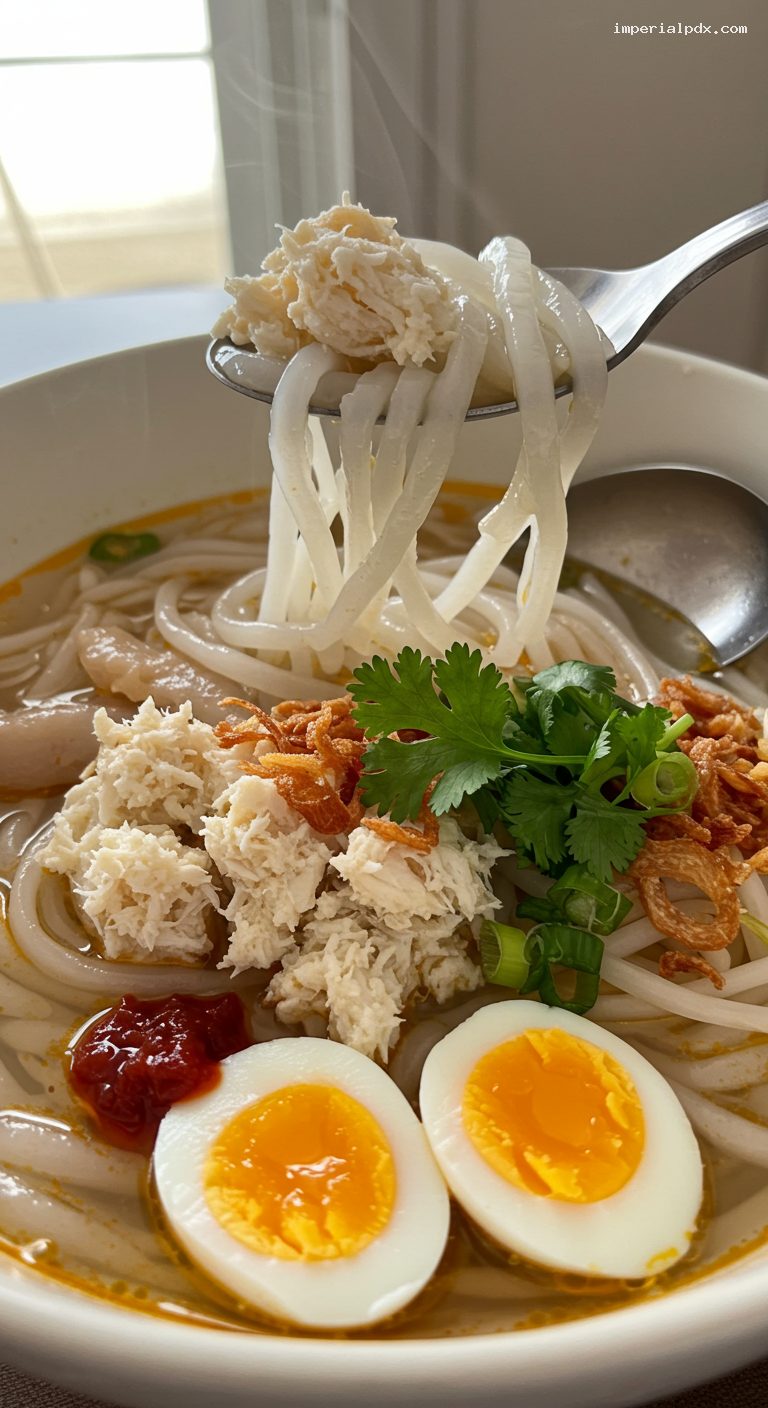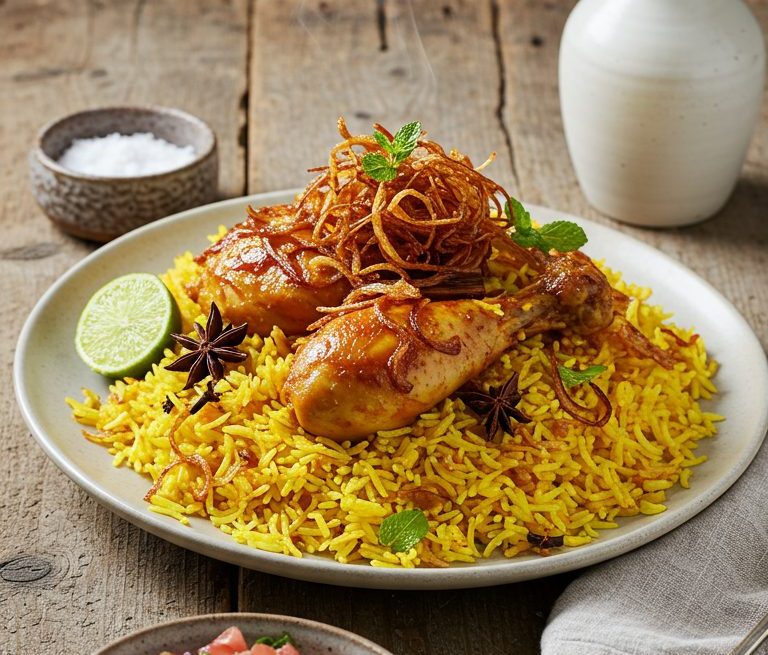Quick Recipe Version (TL;DR)
Quick Ingredients
- 2 lb (900 g) pork neck/back bones
- 10 cups (2.4 L) water; 1 large onion; 7 oz (200 g) daikon (optional); 1 in (2.5 cm) ginger
- 0.5 oz (15 g) dried shrimp (optional); 1 tbsp rock sugar; 3 tbsp fish sauce; white pepper
- 12 quail eggs
- 8 oz (225 g) lump crab meat
- 2 tbsp vegetable oil + 1 tsp annatto seeds (or 1/2 tsp sweet paprika)
- 3 garlic cloves; 1 shallot, minced
- 800 g fresh bánh canh noodles (or 400 g dried)
- 3 tbsp tapioca starch + 1/3 cup (80 ml) cold water
- 4 scallions; cilantro; fried shallots; lime; chili saté for serving
Do This
- 1. Blanch bones 5 minutes in boiling water; drain and rinse.
- 2. Simmer bones with onion, daikon, ginger, and dried shrimp in 10 cups water at 185–195°F for 60 minutes; skim. Season with 1 tbsp rock sugar + 2 tbsp fish sauce; strain to yield ~8 cups.
- 3. Boil quail eggs 4 minutes; ice-bath 5 minutes; peel.
- 4. Make annatto oil (2 tbsp oil + 1 tsp annatto, 2 minutes; strain). Sauté garlic and shallot 30 seconds, add 2/3 of crab + 1 tsp fish sauce; cook 1 minute; reserve. Keep 1/3 crab for topping.
- 5. Cook noodles: fresh 1–2 minutes or dried 7–8 minutes in boiling salted water; rinse and drain.
- 6. Return broth to a simmer; whisk in tapioca slurry (3 tbsp starch + 1/3 cup water). Simmer 2–3 minutes until lightly glossy. Add sautéed crab and eggs; season with 1 tbsp fish sauce and white pepper.
- 7. Assemble bowls with noodles, ladle broth, top with reserved crab, scallions, cilantro, fried shallots, lime, and a dab of chili saté.
Why You’ll Love This Recipe
- Silky, gently thickened broth that clings to chewy tapioca noodles for true comfort in a bowl.
- Sweet crab meat and tender quail eggs add restaurant-level luxury with minimal effort.
- Balanced Vietnamese flavors: clean pork broth, umami fish sauce, and a fragrant annatto aroma.
- Make-ahead friendly: broth and toppings prep well; quick assembly at mealtime.
Grocery List
- Produce: Onion, daikon (optional), ginger, garlic, shallot, scallions, cilantro, limes.
- Dairy: None.
- Pantry: Pork bones, lump crab meat, quail eggs, fish sauce, rock sugar or brown sugar, dried shrimp (optional), vegetable oil, annatto seeds or sweet paprika, tapioca starch, white pepper, fried shallots, chili saté, fresh or dried bánh canh noodles, salt.
Full Ingredients
Pork–Crab Broth
- 2 lb (900 g) pork neck/back bones (or pork hock)
- 10 cups (2.4 L) water
- 1 large yellow onion, halved
- 7 oz (200 g) daikon, peeled and chunked (optional but traditional)
- 1 in (2.5 cm) fresh ginger, sliced
- 0.5 oz (15 g) dried shrimp, rinsed (optional for umami)
- 1 tbsp rock sugar (or packed light brown sugar)
- 3 tbsp fish sauce, divided (2 tbsp for broth, 1 tbsp to finish)
- 1/2 tsp fine sea salt, plus more to taste
- 1/4 tsp ground white pepper (or 1 tsp white peppercorns in the pot)
Crab Topping
- 8 oz (225 g) lump crab meat, picked over for shells
- 2 tbsp neutral oil (canola/vegetable)
- 1 tsp annatto seeds (or 1/2 tsp sweet paprika as color substitute)
- 3 garlic cloves, minced
- 1 medium shallot, minced
- 1 tsp fish sauce
- Pinch white pepper
Noodles and Eggs
- 800 g fresh bánh canh (thick tapioca) noodles, or 400 g dried
- 12 quail eggs
To Thicken the Broth
- 3 tbsp (24 g) tapioca starch
- 1/3 cup (80 ml) cold water
Garnishes & Condiments
- 4 scallions, thinly sliced
- 1/2 cup loosely packed cilantro leaves
- 1/2 cup crispy fried shallots
- Lime wedges
- Chili saté (Vietnamese chili oil), to taste
Optional: From-Scratch Bánh Canh Noodles
- 1 2/3 cups (200 g) tapioca starch
- 1/3 cup (50 g) rice flour (optional, for tenderness)
- 1 cup (240 ml) boiling water
- 1/2 tsp fine salt
- 1 tbsp neutral oil

Step-by-Step Instructions
Step 1: Blanch the pork bones
Place the pork bones in a large pot and cover with cold water by 2 inches. Bring to a rolling boil over high heat. Boil for 5 minutes to purge impurities. Drain, rinse the bones under hot water, and rinse the pot to remove foam. This quick blanch keeps the broth clear and clean-tasting.
Step 2: Simmer a clear, savory broth
Return the cleaned bones to the pot with 10 cups (2.4 L) fresh water, the onion, daikon, ginger, and dried shrimp (if using). Bring to a boil, then immediately lower to a gentle simmer, 185–195°F (85–90°C). Skim any foam. Simmer uncovered for 60 minutes. At the 45-minute mark, season with 1 tbsp rock sugar and 2 tbsp fish sauce. After 60 minutes, strain through a fine mesh into a clean pot; discard solids. You should have about 8 cups (1.9 L). Keep at a bare simmer.
Step 3: Cook and peel the quail eggs
Bring a small pot of water to a full boil. Lower in the quail eggs and cook for 4 minutes for firm yolks. Transfer to an ice bath for 5 minutes, then gently crack and peel. Set aside.
Step 4: Make annatto oil and briefly sauté the crab
Warm 2 tbsp oil and 1 tsp annatto seeds in a small skillet over medium-low heat until the oil turns a deep orange, 2–3 minutes. Strain out the seeds and return the tinted oil to the pan. Add the minced garlic and shallot; sauté 30–45 seconds until fragrant. Stir in 2/3 of the crab with 1 tsp fish sauce and a pinch of white pepper; cook just 60 seconds to warm through without drying. Remove from heat. Reserve the remaining 1/3 crab for topping.
Step 5: Cook the noodles
Bring a large pot of salted water to a boil. For fresh bánh canh, cook 1–2 minutes until translucent and just chewy. For dried noodles, cook 7–8 minutes until tender-chewy. Rinse quickly under warm water to remove excess starch and prevent clumping. Drain well and keep covered.
Step 6: Thicken and finish the broth
Whisk together 3 tbsp tapioca starch and 1/3 cup cold water to make a smooth slurry. Bring the strained broth back to a lively simmer. While whisking, drizzle in the slurry. Simmer 2–3 minutes until the broth is lightly glossy and coats a spoon. Stir in the sautéed crab and the peeled quail eggs; warm 1 minute. Season to taste with the remaining 1 tbsp fish sauce, a pinch of salt, and white pepper. Keep the pot at 185–195°F so the soup stays silky, not boiling.
Step 7: Assemble and garnish
Divide noodles among 4 warmed bowls. Ladle 2 cups of the crab–pork broth into each bowl, ensuring some crab and 3 quail eggs per bowl. Top with the reserved lump crab. Garnish with scallions, cilantro, and fried shallots. Serve immediately with lime wedges and a small spoonful of chili saté per bowl.
Pro Tips
- Clear broth starts with a 5-minute blanch and a gentle 185–195°F simmer; boiling makes it cloudy.
- Add the starch slurry gradually and stop when the broth lightly coats a spoon; you can always add more, but you cannot take it out.
- Do not overcook crab—60 seconds in the pan is enough. Keep a portion raw to top each bowl for sweet, delicate bites.
- Cook noodles separately and store them tossed with a little oil; add to bowls just before serving to keep them bouncy.
- Rock sugar gives clean sweetness, but light brown sugar works in a pinch.
Variations
- Spicy Sate Style: Stir 1–2 tbsp chili saté directly into the pot for a gentle burn throughout the soup.
- Shrimp & Crab: Use shrimp shells for the broth and add poached prawns at the end for a seafood-forward bowl.
- From-Scratch Noodles: Mix tapioca starch, rice flour, salt, and boiling water with oil; knead until smooth. Roll into 1/4-inch ropes, dust with starch, and boil 2–3 minutes until translucent. Rinse and use as directed.
Storage & Make-Ahead
Broth keeps 3 days in the fridge or 2 months frozen. Store noodles, broth, and toppings separately. Quail eggs (peeled) keep up to 3 days refrigerated. Reheat broth gently to 175–185°F; if it thinned during storage, whisk in 1–2 tsp tapioca starch mixed with 1 tbsp cold water and simmer 1–2 minutes. Assemble bowls to order so the noodles stay chewy.
Nutrition (per serving)
Approximate: 560 calories; 24 g protein; 19 g fat; 74 g carbohydrates; 1 g fiber; 1650 mg sodium. Values will vary with noodle type, crab brand, and seasoning.



